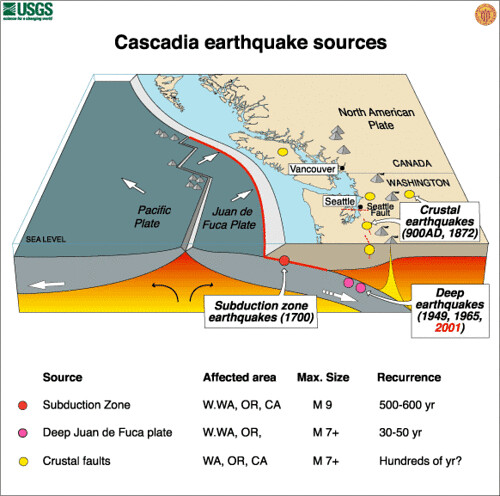PNW Earthquake Sources Overview
Seismologists categorize Cascadia region earthquakes into 4 different types, depending on where they occur, (their "source zones"). Three types in particular, Cascadia Megathrust, Deep Intraplate, and Crustal Faulting earthquakes, may occasionally produce strong shaking that can threaten life and property. The fourth type, volcanic earthquakes, are generally too small and remote to cause damage directly, but they provide strong clues about potential volcanic eruptions.
While only one type (Cascadia Megathrust) actually ruptures a plate boundary, all of these earthquakes can be understood to result from Plate Tectonics.

In Cascadia, strain arises from the interaction of three tectonic plates. The North America, Juan de Fuca, and (indirectly) the Pacific Plate all are moving with different trajectories. Offshore from British Columbia, Washington, Oregon, and N. California, a young oceanic plate called the Juan de Fuca Plate is spreading away from the Pacific Plate and plunging beneath North America. [You might think of building a salami sandwich by holding 2 slices of bread together, and shoving the salami in from the side -- not very efficient, and you're likely to get Mayo everywhere!]. Temporarily locked together (since the great Cascadia Subduction Zone Earthquake of 1700), strain is building in the locked interface between these two plates that will be released in future earthquakes. Read more about the Cascadia Subduction Zone.
The crust of the Juan de Fuca plate, which consists of basalt and marine sediments, is itself placed under strain as it is forced beneath North America and down into the Earth's mantle. The slab is bent and pulled by gravity. In a zone from near the coast line to the foothills of the Cascades but centered on the Puget Lowland, breaks in this subducting slab produce Deep Intraplate earthquakes. Most of the damaging historic earthquakes in Washington State were from this deep earthquake source.
Shallow or Crustal Earthquakes occur on faults in the North American Plate. Some are so shallow they can break or deform the ground surface. Others can occur up to 35 Km deep and may not be associated with faults observed at the surface. Strain from the Cascadia Subduction Zone plays a role in some crustal earthquakes in Western Washington and Oregon but shearing of California as the Pacific Plate grinds along the western edge of the North American Plate to the south plays a bigger role in the generation of crustal earthquakes.
Volcanic earthquakes are triggered by changes in the magmatic system within and beneath the volcano. When magma is injected or removed from the system, surrounding rock will either shift to make room for the injected magma, or fill in a vacated area. These actions are the cause of volcanic earthquakes.